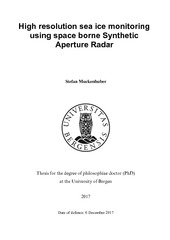| dc.contributor.author | Muckenhuber, Stefan | |
| dc.date.accessioned | 2017-12-19T10:13:53Z | |
| dc.date.available | 2017-12-19T10:13:53Z | |
| dc.date.issued | 2017-12-06 | |
| dc.identifier.uri | https://hdl.handle.net/1956/17036 | |
| dc.description.abstract | Sea ice represents a major factor in the climate system and updated knowl- edge about sea ice conditions is important for shipping and offshore industry, local communities and others. Due to its remote location and strong variabil- ity in extent and motion, satellite observations are among the most important data sources for sea ice monitoring. Considering the polar night and 60 − 90 % cloud coverage over the Arctic, the most reliable sensors for year round, high resolution sea ice monitoring are Synthetic Aperture Radar (SAR) that oper- ate independent of solar illumination and cloud conditions. In the framework of this thesis, the author developed and applied methods for deriving high resolution sea ice information from space borne SAR imagery. A satellite database displaying the area of Svalbard has been established for the time period 2000-2014 and more than 3300 manual interpretations were conducted to distinguish fast ice, drift ice and open water in Isfjorden and Hornsund. The resulting time series revealed a significant reduction of fast ice coverage when comparing the time period 2000-2005 and 2006-2014. The relationship between sea ice, atmosphere and ocean in the two considered fjords has been discussed by comparing fast ice coverage to sea surface temperature from satellite measurements, surface temperature from weather stations and ocean heat content from CTD data. To derive automatic sea ice/water classification of dual polarisation Radarsat-2 SAR imagery, an algorithm based on texture features and support vector machine has been developed and applied opera- tionally in the period 2013 until 2015. Validating the algorithm against 2700 manually derived ice charts from the Norwegian Meteorological Institute revealed an accuracy of 91 4 %. The algorithm showed better performance in winter than in summer. To retrieve sea ice motion information from consecutive SAR images, a feature-tracking algorithm has been developed for Sentinel-1 data based on ORB (Oriented FAST and Rotated BRIEF). The algorithm locates corners, describes the surrounding area and and connects similar corners from one image to the next. The main advantages of the developed feature-tracking algorithm are the computational efficiency and the independence of the vectors in terms of position, lengths, direction and rotation. However, the vector distribution is not controlled by the user. To overcome this issue, a combined algorithm including a pattern-matching ap- proach has been developed as a successor of the introduced feature-tracking algorithm. Based on a filtered feature-tracking vector field, drift and rotation on the entire SAR scene are estimated. This initial drift field limits the search area for a consecutive pattern-matching algorithm that provides small to medium scale adjustments of drift direction, length and rotation. Assessing the potential performance of the combined algorithm with buoy GPS data using 240 Sentinel-1 image pairs yielded a logarithmic normal distribution of the displacement difference with a median at 352.9 m using HV polarisation and 535.7 m using HH polarisation. | en_US |
| dc.language.iso | eng | eng |
| dc.publisher | The University of Bergen | en_US |
| dc.relation.haspart | Paper I: Stefan Muckenhuber, Frank Nilsen, Anton Korosov and Stein Sandven: Sea ice cover in Isfjorden and Hornsund, Svalbard (2000–2014) from remote sensing data, The Cryosphere, 10, 149-158. <a href="http://hdl.handle.net/1956/12264" target="blank">http://hdl.handle.net/1956/12264</a> | en_US |
| dc.relation.haspart | Paper II: Natalia Zakhvatkina, Anton Korosov, Stefan Muckenhuber, Stein Sandven, Mohamed Babiker: Operational algorithm for ice/water classification on dual-polarized RADARSAT-2 images, The Cryosphere, 11, 33-46. <a href="http://hdl.handle.net/1956/17056" target="blank">http://hdl.handle.net/1956/17056</a> | en_US |
| dc.relation.haspart | Paper III: Stefan Muckenhuber, Anton Korosov and Stein Sandven: Open-source feature-tracking algorithm for sea ice drift retrieval from Sentinel-1 SAR imagery, The Cryosphere, 10, 913-925. <a href="http://hdl.handle.net/1956/17057" target="blank">http://hdl.handle.net/1956/17057</a> | en_US |
| dc.relation.haspart | Paper IV: Stefan Muckenhuber and Stein Sandven: Open-source sea ice drift algo- rithm for Sentinel-1 SAR imagery using a combination of feature tracking and pattern matching, The Cryosphere, 11, 1835-1850. <a href="http://hdl.handle.net/1956/17058" target="blank">http://hdl.handle.net/1956/17058</a> | en_US |
| dc.title | High resolution sea ice monitoring using space borne Synthetic Aperture Radar | en_US |
| dc.type | Doctoral thesis | |
| dc.rights.holder | Copyright the author. All rights reserved. | en_US |
| dc.subject.nsi | VDP::Matematikk og Naturvitenskap: 400 | en_US |
